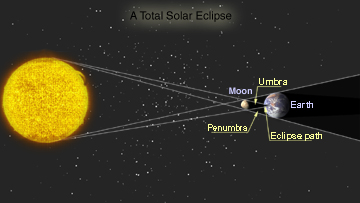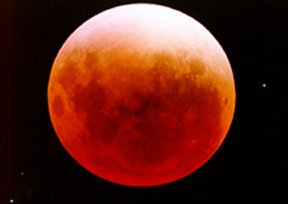November 1993 total lunar eclipse.
Click on image for full size
Courtesy of Andy Steere
Lunar Eclipse January 20, 2000
News story originally written on January 17, 2000
The last lunar eclipse of the millennium in North America is this week! On January 20, 2000, which is Thursday for those living in North America, a total lunar eclipse will occur.
A lunar eclipse is different from a solar eclipse. During a solar eclipse, the Moon passes between the Earth and the Sun. During a lunar eclipse, the Earth's shadow blocks the Sun from the Moon.
There's another important difference. You need to protect your eyes while viewing a solar eclipse, but you can watch a lunar eclipse with your naked eyes!
The lunar eclipse will start near 10:00 pm ET, when Earth's shadow first touches the Moon. It ends at 1:25 ET and the Moon is completely covered from 11:05 to 12:22 am ET.
During the complete cover, a reddish glow will surround the Moon. This is because the Earth's atmosphere scatters blue light.
So, why not take a break from television to witness a very unusual event. If you live in the city, you can still see the eclipse from your own backyard or porch!
You might also be interested in:

An eclipse of the Sun occurs when the Earth passes through the Moon's shadow. A total eclipse of the Sun takes place only during a new moon, when the Moon is directly between the Sun and the Earth. When
...more
It was another exciting and frustrating year for the space science program. It seemed that every step forward led to one backwards. Either way, NASA led the way to a great century of discovery. Unfortunately,
...more
The Space Shuttle Discovery lifted off from Kennedy Space Center on October 29th at 2:19 p.m. EST. The weather was great as Discovery took 8 1/2 minutes to reach orbit. This was the United States' 123rd
...more
A moon was discovered orbiting the asteroid, Eugenia. This is only the second time in history that a satellite has been seen circling an asteroid. A special mirror allowed scientists to find the moon
...more
Will Russia ever put the service module for the International Space Station in space? NASA officials want an answer from the Russian government. The necessary service module is currently waiting to be
...more
A coronal mass ejection (CME) happened on the Sun early last month. The material that was thrown out from this explosion passed the ACE spacecraft. The SWICS instrument on ACE has produced a new and very
...more
J.S. Maini of the Canadian Forest Service called forests the "heart and lungs of the world." This is because forests filter air and water pollution, absorb carbon dioxide, release oxygen, and maintain
...more















